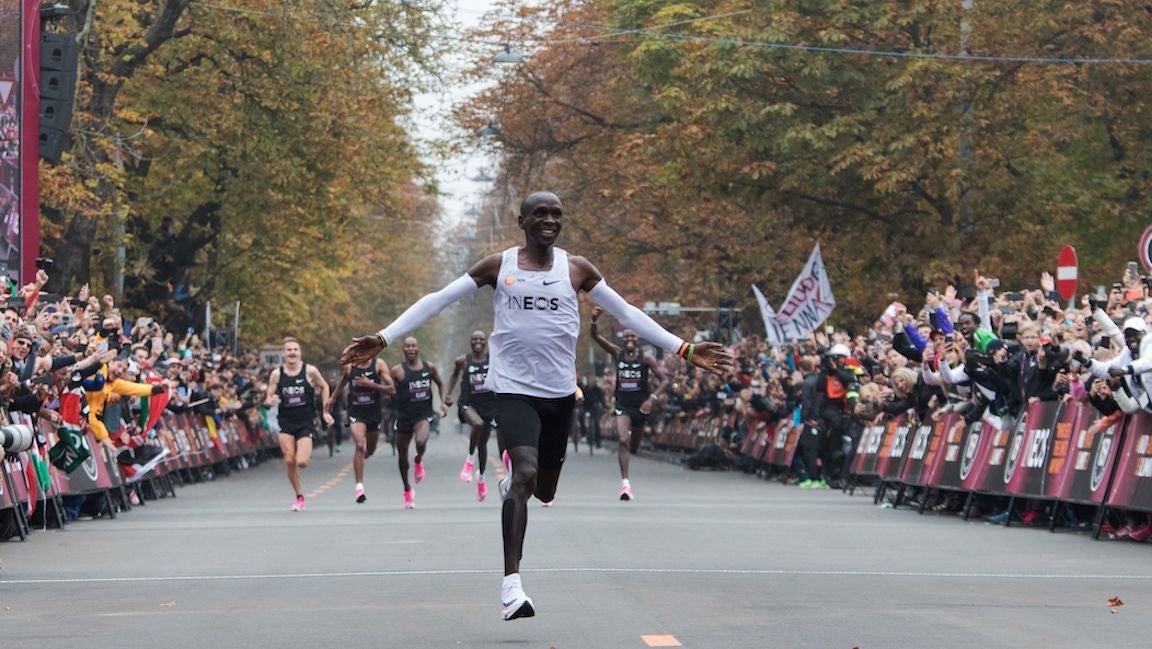In a new paper published Friday in the Journal of Applied Physiology, running experts investigated the physiology and performance of 16 world class male marathoners, including Eliud Kipchoge, Lelisa Desisa, and Zersenay Tadese. The conclusion? These athletes possess a mix of rare abilities that enable them to run sub-2:10 marathons.
A Combination of Variables
It’s not just the VO2 max. It’s not just the way they handle lactate. It’s not just their running economy. These three factors have been associated with elite marathon performance since Michael Joyner highlighted them in his groundbreaking 1991 paper — the first to posit the possibility of a sub-2 marathon.
But top runners don’t succeed with one quality; they need several. “It’s important to recognize that the traditional physiological variables should be considered in combination rather than in isolation,” the research team concluded in the new paper.
What’s more, it’s unusual for any runner to have both a super-high VO2 max and a super-high running economy. The two tend to vary inversely with each other. And there may be a new factor — a fourth — that’s essential to elite marathon performance. Call it “fatigue resistance,” or the ability of the muscles to continue running at high speeds past the marathon “Wall” without requiring more oxygen. If they did need more oxygen, which is typical for a weary runner, then performance would tail off.
“The paper is very impressive,” says Joyner. “We haven’t seen work like this with so many true elite runners since the Mike Pollock and David Costill data in the 1970s. The lactate thresholds were a little higher than I guesstimated in 1991. That means a runner can get to sub-2 with a high, but not a super-high, VO2 max.”
The researchers, including Britain’s Andrew Jones, a longtime runner and running physiologist, also speculated about future improvements on the marathon world record. They believe science is more likely to contribute than evolution or training. “Given that genetic disposition and long-term training” have probably been optimized, they write, “It would appear that scientific innovations and/or strategies which enable a higher mean oxidation metabolic rate to be sustained and/or enhance running economy [like better in-race fuels; or better shoes] will play a significant role in future improvements in marathon performance.”
A Unique Study
The new study was conducted in 2015 and 2016 at Nike headquarters in Beaverton, Ore., and at the University of Exeter, England, where Jones is based. It was part of the buildup to Nike’s Breaking2 marathon exhibition in Monza, Italy, in May 2017. Jones and colleagues studied a group of mostly East African runners including Kipchoge, Desisa, and Tadesse — the threesome eventually selected to race in Monza. Since the data in the new paper is presented for the entire group, not individually, we still don’t know the “stats” on Kipchoge alone.

[In case you’ve forgotten, Eliud Kipchoge ran 2:00:25 in Monza. Seventeen months later, he ran 1:59:40 in the Ineos159 Challenge in Vienna, Austria.]
Conducting detailed research on elite marathoners is notoriously difficult. Sometimes, a scientist can befriend one or two elites, and nudge them into a lab. For example, several decades ago, Jones followed Paula Radcliffe’s treadmill improvement over many years. These case studies are fascinating to read, but amount to “experiments of one.” They can’t provide comparative information beyond the unique individual.
The 16 elite marathon subjects in the new study represent an unusually high number. Not only that, but the researchers tested the runners both in the lab, on treadmills, and outdoors, on a track. They believe no one has previously monitored runners at 4:35/mile pace (equivalent to 60 minutes for a half-marathon) on an outdoor track. They found only small differences between the treadmill and track — mainly the air resistance encountered outdoors. The subjects had an average PR of 60:04 in the half marathon and 2:08:40 at the time they were tested, and have since dropped their marathon time to 2:06:53.
There aren’t a lot of lessons that other runners can learn from the new paper. The elite runners train hard and fast, of course, but they also seem to have great natural talents that might reside deep in their muscle fibers.
The Elite Subjects
On average, the runners were 29 years old, stood just under 5’ 7”, and had BMIs of 19.9. They had an average body fat of 7.9%, and reached a max heart rate of 190. Their leanness probably makes them highly efficient, and good at dealing with the heat generated by long, fast running. They ran in lightweight racing flats, but didn’t yet have access to the soon-to-come Nike Vaporfly 4% shoes.
The runners had average stride-lengths that exactly matched their standing height, and were more likely to run with a non-rearfoot strike. However, footstrike posture didn’t affect any important physiological measures.
The athletes’ running economy varied inversely with the ground-contact time (.16 seconds, on average) of each foot fall. In other words, the faster they picked up their feet, the more economically they ran. They also exhibited a lower “vertical impulse” than that seen in previous elite-runner research. Thus, it’s probably a good thing to eliminate unnecessary “bounce” in your marathon stride.
The 16 marathon subjects had an average VO2 max of 71 ml/kg/min and were able to run at 2-hour marathon pace using 88% of their max. A recent study on Irish over-60 runner Tommy Hughes showed that he could maintain nearly 91% of his max during a marathon race. Last month, Hughes lowered the over-60 marathon record to 2:30:02.
What Mysteries Remain
The VO2 max figure of 71 was lower than some expected. Irish Olympic marathoner Mark Kenneally (with a PR of 2:13:55) is now pursuing his PhD in endurance physiology, and is particularly interested in the training-performance connection. He believes the studied marathon runners were training for high-economy, not for high maximal effort, which could explain the VO2 max result.
“I suspect they trained around a specific pace that was slightly slower than that required by ‘VO2 max intervals’ because a lot of marathon training is about efficiency,” says Kenneally.”
Whatever the explanations, much mystery remains. Researchers can extract various numbers and measures from any group of runners, but a lot stays hidden from view. And it remains true that one of the best ways to succeed in running is to choose your parents carefully.


